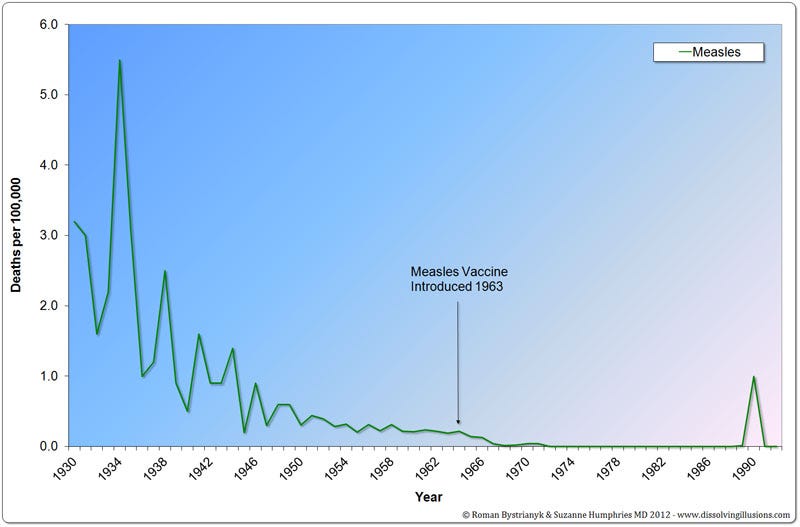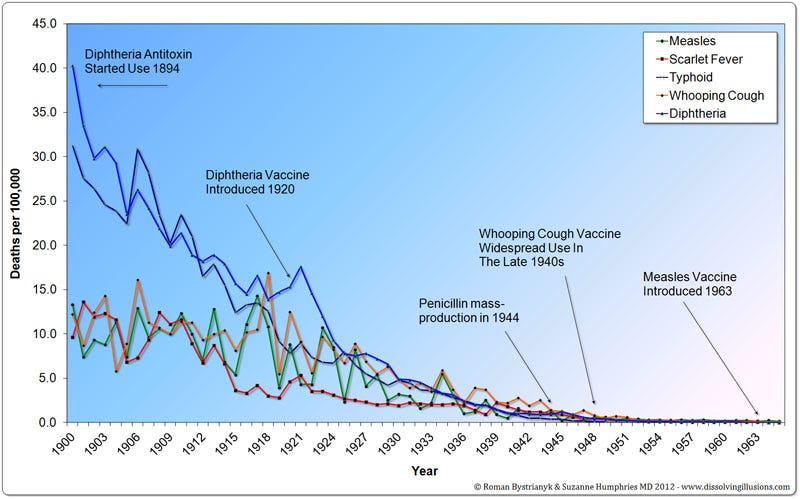Exposing Public Health Myths: The Truth Behind Vaccine Safety, Efficacy, and Herd Immunity
Public Health Myth #1: We Need Vaccines
The Myth: The diseases for which one is vaccinated are deadly and without vaccination we would have epidemics of these diseases with untold numbers of deaths.
The Truth: By the time most vaccines were introduced in the 1950s, diseases like polio, tuberculosis, diphtheria, whooping cough, scarlet fever, small pox, measles, mumps, or chicken pox were mostly mild diseases that rarely caused more than discomfort. By the 1940s, as is the case today, these diseases were rarely deadly in otherwise-healthy adults or children.
Further, there had been a 90 to 99 percent decline for mortality in these diseases BEFORE vaccine programs began. Diseases for which there were no vaccines (scarlet fever, black plague) also declined dramatically in the early to mid-1900s.
The CDC has numerous graphs available showing the rates of infectious disease of all types. The following graph shows death rate for measles from 1900 through 1984. Note that the measles vaccine was introduced in 1963. By that time, death from measles was nearly flat-lining.
From Dissolving Illusions – U.S. Measles Deaths 1930 – 1992
The same pattern is true for diphtheria, typhoid, scarlet fever and whooping cough (notice the spike in diphtheria after introduction of the vaccine).
From Dissolving Illusions – U.S. Deaths 1900 – 1965
So if these diseases were already a minor health threat with infrequent mortality from the middle of the 20th century on, why has there been so much emphasis on vaccination?
Certainly, the unbridled optimism and love affair with scientific progress that followed World War II are part of the equation.
Hubris is another factor. This arrogance is evident from a statement made by Alexander Langmuir, MD in a paper entitled “The Importance of Measles as a Health Problem” that appeared in The Journal of Public Health in 1962.
Langmuir, hailed now as the “father of epidemiology,” wrote: To those who ask me, “Why do you wish to eradicate measles?” I reply with the same answer that Hillary used when asked why he wished to climb Mt. Everest. He said, “Because it is there.” To this may be added, “and it can be done.” In the same paper he admitted that measles were already a “… self-limiting infection of short duration, moderate severity, and low fatality.” (Dissolving Illusions, p.402)
Though the deadly threat to public health from diseases that are part of the routine childhood vaccination schedule had virtually disappeared before vaccination programs began, scientists pushed forward apparently for the sake of science itself.
This scientific arrogance, with its disregard for potential health consequences posed by vaccines, takes on greater relevance when one realizes that Langmuir created the Epidemic Intelligence Service for the U.S. Government; he also headed the epidemiology section of the organization that became the Centers for Disease Control (CDC).
Langmuir’s New York Times obituary said, “He thrived on controversy and often took pride in overcoming local political pressures to crusade for preventive medicine and other measures to safeguard public health. He relished jurisdictional and other fights with state and Federal officials and other scientists, including some on his own staff.” (http://www.nytimes.com/1993/11/24/obituaries/alexander-langmuir-dies-at-83-helped-start-us-disease-centers.html)
Since Langmuir’s campaign to safeguard public health, the United States has more sick children than ever before, and more than other developed countries. Fifty percent of school aged children have one or more chronic health issues. These chronic conditions last much longer than the mild viruses that sickened earlier generations. And many of these conditions can often be linked to side effects of vaccines.
The danger posed by a misplaced trust in the science that created (and now often mandates) vaccinations can be seen in the fact that the incidence of, and death from, diseases like small pox spiked dramatically after wide scale vaccination programs began. In fact, the incidence of most diseases spiked upwards after the introduction of vaccines. Doctors now also know that people can contract or shed viruses after vaccination, which has contributed to outbreaks of diseases that vaccines were meant to prevent.
With modern vaccines, polio was especially troublesome following its introduction in 1954. Thousands of those vaccinated in 1955 with the Salk vaccines manufactured by both Cutter and Wyeth Labs contracted polio from the vaccine.
From the Cutter version of the vaccine:
220,000 were infected
70,000 developed the symptomatic muscle weakness
164 developed severe paralysis
10 died
Family members and community members also contracted the same strain of vaccine-induced polio. Much of this information was concealed from the public as it occurred and only came to light in 1990 after the Freedom of Information Act revealed more details, including information about the Wyeth Lab strain problems. (from Dissolving Illusions by Suzanne Humphries, MD and Roman Bystrianyk, pp 270-1).
And the measles and diphtheria/pertussis/tetanus vaccines top the list for compensated claims of death and disability over the last thirty years.
For further reading see:
See also trends for other diseases, pre-vaccine.
www.cdc.gov/nchs/data/vsus/vsrates1940_60.pdf (CDC charts start around page 80.)
Trends in Infectious Disease Mortality in the United States During the 20th Century (JAMA):
http://jama.jamanetwork.com/article.aspx?articleid=768249#FIGJOC80862F4
http://www.vaclib.org/intro/present/index.htm#8
http://www.vaclib.org/sites/debate/web1.html
Additional Graphs Including United States Disease Death Rates:
www.dissolvingillusions.com/graphs
Public Health Myth #2: Vaccines Saved Lives
The Myth: Vaccines were responsible for a decline in both occurrences (morbidity) and deaths (mortality) from diseases that had plagued previous generations.
The Truth: The real public health miracle that saved so many lives and prevented so much disease occurred prior to the introduction of vaccines in the 1950s and 60s. Public reaction by the entire town of Leicester England to the small pox (a vaccine introduced in the late 1700s), proved that cleanliness and good nutrition mattered more than vaccination.
Elimination of the deadly nature of disease is more correctly attributed to four important changes that spanned the late 19th and early 20th centuries:
Regulations to promote public works projects to build sewer systems that disposed of human and animal wastes (which had been on the streets and in open gutters) and sanitation service to remove garbage; these measures effectively cleaned living quarters and city streets so that people were no longer in regular contact with feces and rotting garbage.
Public works projects that delivered clean, safe drinking water, a measure that was especially important in overcrowded tenements urban areas. Clean drinking water is essential for preventing deaths from diarrhea—which was then, as it is still, one of the leading causes of death in children worldwide.
Food safety regulations that prevented distribution of tainted meats and produce, especially to the poor who could only afford the lowest grade foods.
Child labor laws to protect children from working in factories and mines. Add to this the rise of labor unions which fought for wages that lifted families out of poverty. More money earned by adults in a family ensured that children had better nutrition and a more developmentally appropriate environment. This reduced the stresses on their small bodies and added to their overall health improvement and resilience.
Improved living conditions, clean food and water, and the reduction of poverty, strengthened people’s overall health so much that the body’s natural immune system was able to handle infectious diseases. Diseases that had been deadly remained in the community in the 1900s but no longer posed the mortal threat they had in the 1800s.
It is easy to see the truth of this premise following natural or man-made disasters which disrupt a community’s access to sanitation, good food, and clean water. People huddled and crowded into camps without these essentials soon fall prey to any number of infectious diseases. The filth associated with the conditions is only one issue; the trauma and stress experienced also depresses immune function leaving people more vulnerable to disease.
Disease thrives on filth, poverty, and trauma (emotional, psychological, and physical). Address them and health improves without vaccines.
Public Health Myth #3: Trust Your Government
The Myth: We can and should trust governmental agencies that mandate vaccines as a matter of public health.
The Truth: There are many conflicts of interest, including financial or career incentives, in the governmental agencies (CDC, FDA, HHS) responsible for public health and safety that give rise to issues of trustworthiness.
Pharmaceutical lobbyists outnumber members of Congress, and campaign donations are spread across both political parties. And pharmaceutical lobbyists, as a group, have a budget greater than some countries. Do the profit motives mask growing concerns over the safety of this highly profitable medical intervention?
Ethical considerations are another concern. The advancement of science (sometimes only for sciences’ sake), and governmental agencies that desire to use those advances for the public good, continues to suffer from the same preconceptions and blind spots about the value of some lives versus others that has plagued this country since the first eugenics proponents spouted their theories at the beginning of the 20th century.
These ethical blind spots are responsible for a record of deadly errors from unsafe drugs, immoral experimentation on uninformed or coerced subjects, and “public health” legislation that is troubling at best and criminal at worst.
An incomplete list includes:
1932 – 1972: the Tuskegee syphilis experiments performed on African American men sponsored by the U.S. Public Health services (USPHS)
1946 – 1948: USPHS and the National Institute of Health (NIH) experiment on 700 detained Guatemalans who were intentionally infected with sexually transmitted diseases
1941: experiments exposing mentally ill patients to freezing temperatures for 80 – 120 hours (called the “refrigeration” experiment) conducted at Longview State Hospital (Cincinnati) and McLean Hospital (part of Harvard University)
1957: the drug Thalidomide was given to pregnant women as an anti-nausea drug causing miscarriage and/or terrible birth defects
1950s: Polio vaccine caused deaths and paralysis; cancer causing SV-40 virus given to millions
1956 -1972: “mentally retarded” children at the Willowbrook State School in New York were deliberately infected with hepatitis for an experiment meant to track the development of the infection. Parents were coerced to participate as a condition for admission to the school.
1986-2000: thousands of children in foster care (wards of seven states) who ranged in age from infants to late teens and were from mostly poor minority backgrounds were used as human subjects in HIV/AIDS drug and vaccine trials sponsored by the government and corporations; no parental consent or approval from independent advocates was obtained (a violation of federal law); some died. (VE p 91)
Flu vaccine deaths and injuries (1976, 2009)
Estimates for up to 500,000 deaths from Vioxx, a drug produced and marketed by Merck despite Merck’s foreknowledge of the drugs dangers
1993-96: Fenfluramine experiments on 100 mostly poor, African American and Hispanic boys aged 6-11; researchers at the New York State Psychiatric Institute (with the approval of, and funding from, the National Institute of Mental Health) injected this known neurotoxin into the boys in an experiment that set out to “prove” that there is a biological marker for criminal behavior; this research used and damaged healthy children for experiments with no therapeutic value
Tobacco and DDT deserve special mention. Tobacco companies advertised their products heavily in all media for decades. When serious questions arose about the health dangers of tobacco use following a report by Morton Levin in 1950 linking smoking to lung cancer, tobacco companies used company sponsored “scientific research” to prove that tobacco did not cause cancer. This went on for decades before the government finally acknowledged a direct link between smoking and lung cancer, banned tobacco advertising in magazines and television, and placed warning labels on cigarettes.
Public Health Myth #4: Vaccines Are Safe
The Myth: Vaccines are safe and effective; long ago they were proven to prevent disease and research studies proved that they are safer than the diseases they prevent.
Keep reading with a 7-day free trial
Subscribe to RevealedEye's Newsletter to keep reading this post and get 7 days of free access to the full post archives.







